#Bloom Taxonomy
Text
Diario PA1. Conecta con el currículum y Evaluación
1. ¿Qué ideas nuevas te ha suscitado el bloque?
Este nuevo bloque ha cerrado el círculo de los elementos transversales del paisaje. Me ha permitido conectar mis actividades y mis bloques de contenido con las competencias y criterios de evaluación, todo ello girando en torno a las inteligencias y los niveles de la taxonomía de Bloom para dar respuesta a todos mis alumnos.

2. ¿Cómo se conecta con lo que ya haces en el aula?
Como actualmente no estoy ejerciendo como docente, asesoro a mis centros en el diseño de actividades que permitan a los alumnos a alcanzar los objetivos propuestos con diferentes ritmos de aprendizaje y respondiendo a la diversidad, utilizando nuevos espacios que permitan y motiven el uso de metodologías activas como el aula del futuro.
Así mismo, intento transmitirles los beneficios de crear itinerarios con diferentes alternativas para poder dar respuesta a las diferentes inteligencias.

3. ¿Qué herramientas de evaluación conoces y podrías incluir en tu paisaje?
Como docente, estoy familiarizado con una variedad de herramientas de evaluación que pueden adaptarse a diferentes situaciones y necesidades de los estudiantes. Por su versatilidad, y porque se amoldan mejor a la situación de aprendizaje diseñada, incluiría en mi paisaje de aprendizaje las rúbricas, el diario de aprendizaje y las listas de control.

4. ¿Cómo has incluido la evaluación en el paisaje que estás diseñando?
En el diseño de mi paisaje de aprendizaje, he integrado la evaluación como un componente continuo y formativo. Desde el principio, establezco objetivos de aprendizaje claros y criterios de evaluación que guían el diseño de las actividades y la selección de los recursos. Durante el proceso de enseñanza-aprendizaje, implemento diversas formas de evaluación formativa para monitorear el progreso de los alumnos y proporcionar retroalimentación oportuna. Ellos son conocedores desde el principio de las rúbricas con las que van a ser evaluados, teniendo a su disposición los instrumentos que se van a emplear para hacer un seguimiento de su proceso de aprendizaje a través de las evidencias presentadas.
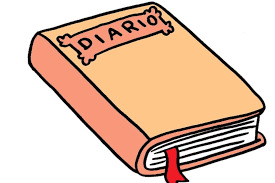
0 notes
Text
Bloom's Taxonomy vs Solo Taxonomy: A Comparative Analysis
Understanding the key frameworks in education, such as Bloom's Taxonomy and Solo Taxonomy, is crucial for educators and learners alike. Bloom's Taxonomy, developed by Benjamin Bloom, offers a hierarchical model that categorizes learning objectives into six levels. These levels are:Read more.
#Affective domain#Analyzing#Bloom Taxonomy#Cognitive domain#Learning progression#Metacognition#Psychology#Self-assessment#Solo Taxonomy learning outcomes#SoloTaxonomy#Teaching strategies#Applying#Curriculum design#Evaluating#Instructional strategies#Philosophy#Professional development#Psychomotor domain#Remembering#Understanding#Bloom taxonomy levels#Bloom Taxonomy Domains#Domains of Bloom Taxonomy#Key Features and Applications of Bloom Taxonomy#Applications of Bloom Taxonomy#Why should we use Bloom Taxonomy?#Why should we not use Bloom Taxonomy?#Bloom taxonomy in education#cognitive training#cognitive behavioral therapy
0 notes
Text
What that post about media literacy and literacy rates doesn't factor for is that media literacy is a related but separate skill from traditional literacy. While literacy is focused on the ability of reading and writing, media literacy is focused on analysis, evaluation, and synthesis. The ability to do the former precludes the ability to do the latter, but not vice versa — someone can be literate yet in want of media literacy skills, and acquiring one is highly important but cannot substitute the other completely, nor is mentioning or even lamenting one doing anything to take away from the importance of and statistics on the other.
There's this thing in education called Bloom's Taxonomy, which is sort of like a Hierarchy of Needs (people on this site are familiar with that, right, from the memes I've seen) but for learning and demonstrating processes.
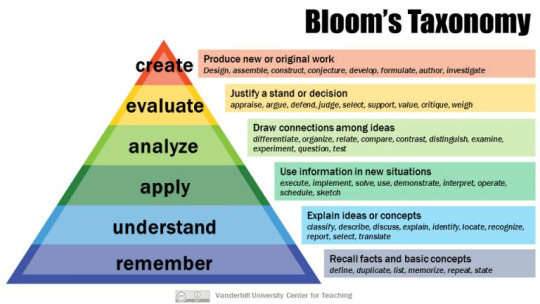
Wherein lower tier concepts are subsumed within doing higher tier concepts; to apply, you have knowledge/remember and understanding, for example.
So for literacy, you're at least getting the remember/knowledge and the understanding, and probably some of the application. But media literacy often focuses on application and analysis at least. You can get how this makes it a different skill set, yeah?
Literacy is highly important. Media literacy is often important, too. Discussing how people could gain better skills of analysis, evaluation, and synthesis (even if it is done upon seeing "a bad take") isn't a proclamation that those people don't have general literacy (and therefore a trivialization of the challenges posed towards those who do not have it), it's a statement about a different set of skills that happen to be related but not identical to literacy, and happen to have the same word in the name because of that.
And let's not even get into information literacy and digital literacy right now, because I'm tired. But those are also specific skill sets that don't trivialize literacy to talk about the importance of.
Anyway, it's 3AM, I'm posting about a post I could have scrolled past instead, good night good hunting and go straight home
#rubia speaks#literacy#media literacy#Bloom's Taxonomy#a post about a post#please do not clown on the post in bad faith i do not want to edit it to make you answer multiple choice in it at the end
4 notes
·
View notes
Text
6 keys to critical thinking based on Bloom's taxonomy
6 keys to critical thinking based on Bloom’s taxonomy

View On WordPress
3 notes
·
View notes
Text
Mastering Microlearning: Harnessing Bloom's Taxonomy for Effective Learning

Introduction
In the realm of training, Bloom's Taxonomy stands as a cornerstone framework for designing learning objectives and assessing learning outcomes. With the rise of microlearning – a strategy that delivers small, focused learning units – integrating Bloom's Taxonomy becomes paramount for ensuring that learning experiences are comprehensive and impactful. In this article, we delve into the principles of Bloom's Taxonomy and explore how it can be effectively utilized in the context of microlearning to enhance learning outcomes.
Understanding Bloom's Taxonomy
Developed by educational psychologist Benjamin Bloom in the 1950s, Bloom's Taxonomy classifies learning objectives into six hierarchical levels, organized from simple to complex cognitive processes. These levels are:
Remembering: Recalling information or facts.
Understanding: Grasping the meaning of information.
Applying: Applying knowledge or skills in new situations.
Analyzing: Breaking down information into parts and understanding relationships.
Evaluating: Making judgments based on criteria and standards.
Creating: Generating new ideas, products, or solutions.
Bloom's Taxonomy provides a framework for educators to design learning experiences that foster higher-order thinking skills and promote deep understanding.
Integrating Bloom's Taxonomy into Microlearning
When applied to microlearning, Bloom's Taxonomy serves as a guide for structuring learning content and activities that promote meaningful engagement and learning. Here's how each level of Bloom's Taxonomy can be integrated into microlearning:
Remembering (Recall):
Microlearning modules can include brief quizzes or flashcards to reinforce memorization of key facts or concepts.
Utilize short audio or video clips to recap essential information covered in previous modules.
Understanding (Comprehension):
Present microlearning content in a clear and concise manner, using multimedia elements to enhance comprehension.
Incorporate examples, case studies, or scenarios to help learners grasp the meaning of complex concepts.
Applying (Application):
Include interactive simulations or scenarios that require learners to apply their knowledge to solve practical problems.
Provide real-world examples or case studies that illustrate how concepts can be applied in different contexts.
Analyzing (Analysis):
Break down complex topics into smaller components, with each microlearning module focusing on a specific aspect of analysis.
Encourage learners to compare and contrast different perspectives or approaches to a problem through short activities or discussions.
Evaluating (Evaluation):
Prompt learners to critically evaluate information or arguments presented in microlearning modules.
Include opportunities for peer feedback or self-assessment to encourage reflective thinking and evaluation of one's own learning.
Creating (Creation):
Engage learners in creative activities that allow them to generate new ideas, designs, or solutions.
Encourage learners to collaborate on short projects or assignments that involve creating something tangible or innovative.
Benefits of Using Bloom's Taxonomy in Microlearning
Promotes Higher-Order Thinking: Integrating Bloom's Taxonomy into microlearning encourages learners to engage in higher-order cognitive processes, such as analysis, evaluation, and creation, leading to deeper understanding and critical thinking skills.
Enhances Learning Outcomes: By aligning microlearning activities with Bloom's Taxonomy, educators can design learning experiences that target specific cognitive skills and learning objectives, resulting in more effective learning outcomes.
Facilitates Personalized Learning: Bloom's Taxonomy provides a framework for designing personalized learning paths tailored to individual learner needs and preferences, ensuring that each learner receives content at an appropriate level of complexity.
Encourages Active Engagement: Incorporating diverse activities at different levels of Bloom's Taxonomy promotes active engagement and participation among learners, fostering a dynamic and interactive learning environment.
Provides Clear Progression: Bloom's Taxonomy offers a clear progression of cognitive complexity, allowing learners to scaffold their learning from basic recall to higher-order thinking skills, providing a sense of achievement and progress.
Case Study: Implementing Bloom's Taxonomy in Microlearning
Imagine a corporate training program aimed at improving employees' customer service skills. By integrating Bloom's Taxonomy into microlearning modules, the training program can be structured as follows:
Remembering: Employees recall the key principles of excellent customer service through short quizzes or flashcards.
Understanding: Employees watch brief videos explaining different customer service scenarios and how to respond effectively.
Applying: Employees participate in interactive simulations where they practice handling various customer service situations.
Analyzing: Employees analyze case studies of real customer interactions to identify areas for improvement and best practices.
Evaluating: Employees assess their own performance in customer service scenarios and receive feedback from peers or supervisors.
Creating: Employees collaborate on developing innovative solutions to common customer service challenges and share their ideas through short presentations or discussions.
Conclusion
Integrating Bloom's Taxonomy into microlearning offers a powerful approach to designing effective and engaging learning experiences. By aligning microlearning activities with the cognitive processes outlined in Bloom's Taxonomy, educators can create targeted learning modules that promote deep understanding, critical thinking, and practical application of knowledge. As organizations continue to embrace microlearning as a flexible and efficient training solution, leveraging the principles of Bloom's Taxonomy will be instrumental in maximizing the impact of microlearning initiatives and driving positive learning outcomes.
#bloom's taxonomy#bloomberg's taxonomy#bloom s taxonomy#styles of learners#learning and learning styles#learning skills#different learning styles#learning methods#4 learning styles#skills learning#bloom's taxonomy of learning#levels of bloom's taxonomy#bloom's levels#levels in bloom's taxonomy#bloom's taxonomy in learning#bloom's taxonomy for learning#bloom level taxonomy#bloom's learning#blooms levels#bloom revised taxonomy#blooms taxonomy questioning#learning and learning#learning more#learning about learning#learning modality#learning stages#different methods of learning#skills of a learner#different type of learning styles#different learning modes
0 notes
Text
Taxonomía de Bloom: Qué es y cómo aplicarla en el aula
Esta clasificación facilita el diseño de actividades y la evaluación de los conocimientos adquiridos en un área o materia.
A grandes rasgos, la Taxonomía de Bloom es una lista de objetivos (o niveles) que evalúan el proceso de aprendizaje de cualquier estudiante, además de un punto de partida útil para diseñar de forma lógica actividades y ejercicios y conseguir un aprendizaje significativo que…
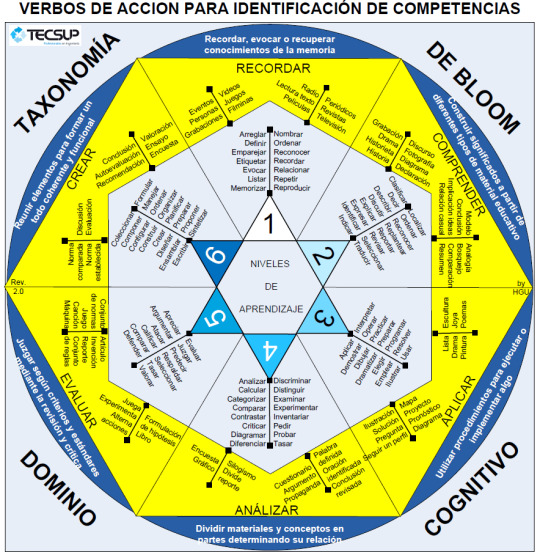
View On WordPress
0 notes
Text
Maslow before Bloom
In my work as a personal leadership coach, this mantra.
People must have their fundamental human needs addressed before we can get into professional development. So my coaching conversations always begin with a real, conscious check-in of how they are doing, as people.
0 notes
Note
this valentine’s day i would like to profess my undying, ardent love for the callistephus chinensis (china aster)! the flower that contributed to me giving myself my name!!


not only are they a part of the (superior in my opinion) family of asteraceae, but also the genus’ (callistephus) etymology is derived from the greek words “kalli-” meaning “beautiful” and “stephos” meaning crown. they have beautiful chrysanthemum-esque blooms and come in all sorts of colours (my favourites being purple and white).
straying away from taxonomy a bit, asters in general are one of the birth flowers for september (my birth month!). they symbolise hope, faith and wisdom. and according to greek mythology, astraea (“star maiden”: goddess of purity, justice and innocence) cried because there weren't enough stars in the sky and when her tears hit the earth, they caused asters to bloom! continuing to follow the greek myth, she was the last goddess to live amongst the humans after the golden age, symbolising the decline of hope for humanity along with the decline of the ages. she left and became the constellation virgo i believe!
some more fun fun facts, asters have a most frequently observed number of n = 9 haploid chromosomes (2n = 18 for diploid). the numerology of the word “aster” also happens to be nine and guess what! september is the 9th month of the year! is it obvious i really like the number 9? almost as much as i love asters <3
String identified:
t at’ a t g, at t cat c (ca at)! t tat ctt t gg a!!
t a t a at t ( ) a ataca, t a t g’ (cat) tg t g “a-” ag “at” a “t” ag c. t a at cat- a c a t c ( at g a t).
tag aa ta a t, at ga a t t t ( t t!). t , at a . a accg t g tg, ataa (“ta a”: g t, tc a cc) c ca t 't g ta t a ta t t at, t ca at t ! ctg t t g t, a t at g t agt t a at t g ag, g t c at ag t t c t ag. t a ca t ctat g !act, at a a t t = 9 a c (2 = 18 ). t g t “at” a a t a g at! t t 9t t t a! t a t 9? at a c a at <3
Closest match: Caligus rogercresseyi isolate FCH chromosome 9
Common name: Sea louse
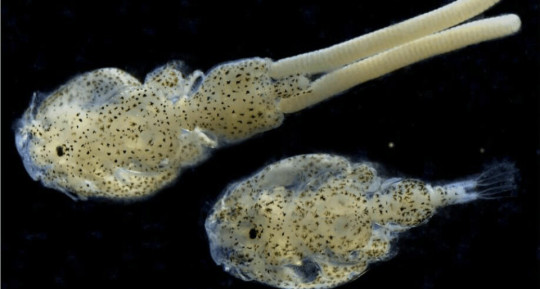
#tumblr genetics#genetics#valentines day#asks#requests#sent to me#thisisasteresque#flowers#plants#china aster#parasites#ocean#sea louse
2K notes
·
View notes
Text
What an International School might look like in the future
In recent years, many international schools have been shifting towards a more personalized, competency-based approach to teaching. This approach focuses on providing students with a learning experience tailored to their individual needs and passions.
In recent years, many international schools have been shifting towards a more personalized, competency-based approach to teaching. This approach focuses on providing students with a learning experience that is tailored to their individual needs, passions and abilities. International schools adopt this approach and are increasingly incorporating technology and data to track student progress and…
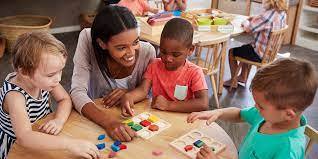
View On WordPress
#a level#bloom&039;s taxonomy#collaborative learning#curriculum#Education#ib#IBDP#igcse#international education#international schools#online learning#project based learning#project centred learning#real-world projects#remote learning#scheduling#schools#service learning#technology
1 note
·
View note
Text
Diario E2. El corazón del dragón
¿Qué ideas nuevas te han suscitado estos últimos bloques?
La taxonomía de Bloom, las inteligencias múltiples y la matriz para atender a las distintas necesidades de los alumnos son herramientas educativas muy importantes y útiles. La taxonomía de Bloom nos ayuda a clasificar y organizar los objetivos de aprendizaje, permitiendo diseñar actividades que promuevan un pensamiento más profundo y crítico. Por otro lado, las inteligencias múltiples nos recuerdan que cada estudiante tiene habilidades y fortalezas únicas, por lo que es importante ofrecerles oportunidades para desarrollar todo su potencial. Finalmente, la matriz para atender a las distintas necesidades de los alumnos nos ayuda a personalizar la enseñanza, adaptándola a las necesidades específicas de cada estudiante para garantizar su éxito académico. Son herramientas muy valiosas para promover un aprendizaje significativo y equitativo.
¿Es viable crear un entorno de aprendizaje basado en los niveles de pensamiento? ¿Crees que con esta herramienta se puede responder a la diversidad? ¿De qué manera?
Sí, es viable crear un entorno de aprendizaje basado en los niveles de pensamiento de Bloom. En cuanto a los paisajes de aprendizaje, también pueden ser una herramienta efectiva para responder a la diversidad en el aula. Al crear un ambiente de aprendizaje donde los estudiantes tengan diferentes opciones y caminos para alcanzar los objetivos de aprendizaje, se les brinda la oportunidad de aprender a su propio ritmo y de acuerdo con sus intereses y habilidades individuales.
¿Qué posibilidades y requerimientos encuentras en la metodología?
Los paisajes de aprendizaje pueden ayudar a los estudiantes a desarrollar habilidades de colaboración y resolución de problemas al trabajar en diferentes actividades en grupo y al comunicarse e intercambiar ideas con sus compañeros de clase.
En general, tanto la metodología de Bloom como los paisajes de aprendizaje pueden ser herramientas útiles para crear un entorno de aprendizaje más inclusivo y diverso, donde todos los estudiantes tengan la oportunidad de alcanzar su máximo potencial de aprendizaje.
El requerimiento principal desde mi punto de vista es la formación que necesita el docente tanto en metodología como en competencia digital para poder afrontar y ofrecer este abanico de posibilidades a los alumnos.
0 notes
Text
Bloom's Taxonomy: A Framework for Effective Teaching and Learning
Bloom's Taxonomy is a framework for categorizing and organizing the different levels of thinking and learning that are involved in education. It was first developed in the 1950s by educational psychologist Benjamin Bloom with his colleagues, and it was first published in the book “Taxonomy of Educational Objectives” in 1956. The framework has been widely used in curriculum design, assessment, and instruction in various educational settings. Read more
#Affective domain#Analyzing#Applying#Cognitive domain#Curriculum design#Evaluating#Instructional strategies#Philosophy#Professional development#Psychology#Psychomotor domain#Remembering#Understanding#Bloom taxonomy levels#Bloom Taxonomy Domains#Domains of Bloom Taxonomy#Key Features and Applications of Bloom Taxonomy#Applications of Bloom Taxonomy#Why should we use Bloom Taxonomy?#Why should we not use Bloom Taxonomy?#Bloom taxonomy in education#cognitive training#cognitive behavioral therapy#cognitive skills#cognition#cognitive science#intelligence services
1 note
·
View note
Text
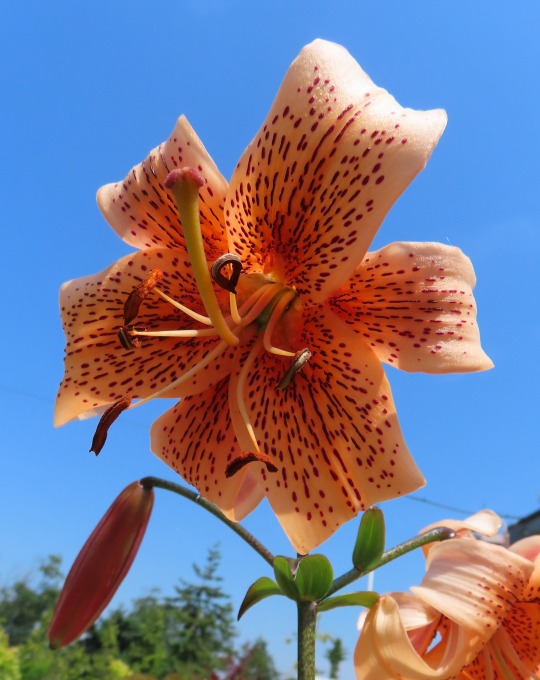
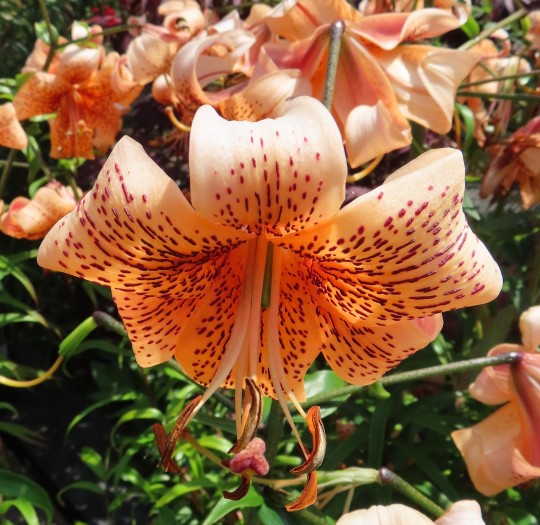
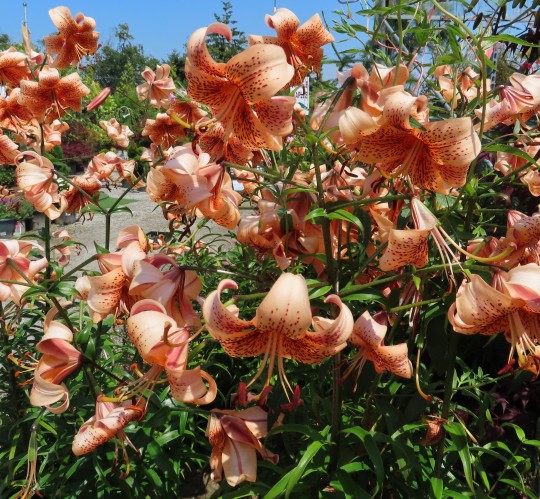
Lilium lancifolium syn. L. tigrinum (tiger lily, lance-leafed lily, var: "Splendens")
Tiger lilies always like to 'dress to impress' 'and this clump at the entrance of a local golf course is putting on quite a show. This cultivar "Splendens" has been bred for heavy flowering and can produce up to twenty-five blooms a season from a single stalk! If you plant three of them, the bulbs will reproduce sideways and you'll have a show garden full of tiger lilies in about ten years time.
The scientific name of the tiger lily used to be Lilium tigrinum, which makes sense because tigris is Latin for tiger. However it was later discovered that an earlier botanist had named this species Lilium lancifolium from the Latin lancea ("lance") + folium ("leaf"). In the hothouse world of botanical taxonomy. precedence matters, and (seriously) naming rights can make or break a botanist's career. Not that these beautiful tiger lilies, basking in the afternoon sunshine, really give a hoot about what botanists call them.
#flowers#photographers on tumblr#tiger ily#gardening#botany#fleurs#flores#fiori#blumen#bloemen#vancouver
318 notes
·
View notes
Text
Fun fact! There is a difference between criticism and criticism.
criticism (n). saying something is bad
criticism (n). critique; the practise of evaluating and analysing works of art or literature
evaluate (v). making supported, informed judgements about the value and efficacy of elements of a work, or a work as a whole
analyse (v). to discuss the structure and relationships present in a work
n.b. My definitions of ‘evaluate’ and ‘analyse’ are drawn from their use in pedagogy and educational settings, particularly Bloom’s Taxonomy.
I think a lot of people I see on this webbed site think they’re being critical (2) when they’re actually being critical (1), and a lot of people see others talking about critical (1) and think they’re talking about critical (2).
Yes, it’s confusing, but if you use your context clues* to analyse and evaluate what someone is saying, you too should be able to identify whether a use of the word critical refers to (1) or (2).
For example, the phrases literary criticism and critical race theory are referring to critical (2).
On the other hand, someone on tumblr dot com talking about what they didn’t like in a TV show is probably being critical (1).
Crucially, criticism (2) should not be about whether a work is ‘good’ or ‘bad,’ or whether you liked it or not. It should be about evaluating how effective the work was at executing its intention.
Three building block questions toward criticism (2) are:
What was the artist/writer trying to communicate with this work?
Did they achieve it?
Why/how do you come to this judgement?
Yes, opinion is still present in criticism (2)—the objective criticism does not truly exist. However, I will refer you to two of the words in the definition given for ‘evaluate’: supported and informed.
This is quick and not at all comprehensive, but wouldn’t it be nice if in 2024, tumblr learned how to read? Wouldn’t it be nice?? Wouldn’t it???
*Context clues are generally the other words in a sentence or paragraph which also contribute to the writer’s intention being conveyed. If you don’t understand one word being used, have a look at the rest of the words written, as well as the form and use of punctuation! They can help to provide context**
**context (n.) 1. the connected conditions which surround something, such as its environment. 2. the parts of a discourse*** which can be analysed**** to show its meaning
***discourse (n.) literally just means an exchange of ideas, especially a formal and organised expression thereof like fucking hell how did it come to mean controversy or hysteria in online spaces Foucault is spinning in his goddamn grave
****analyse (v.) see above
62 notes
·
View notes
Text
What species are the flowers in Fowler's fortress?
The flower with psychoactive pollen we see in episode 6 is probably entirely fictional, and not based on any specific plant. BUT Pondering over small, inconsequential details like this seems to have become my thing, so let's consider what it could be if it IS a real flower.
Based on its shape, the flower looks either like a waterlily or a lotus.
Fowler's indoor garden seems to be either directly above or otherwise near to the kitchen. Any water features such as fountains and ponds would need to be self-contained (to avoid leaking, or rotting the wooden beams between floors). Also, given how dimly lit the windowless garden is we can assume the flower blooms in the dark / nocturnally which actually narrows down which species of flower it could be considerably.
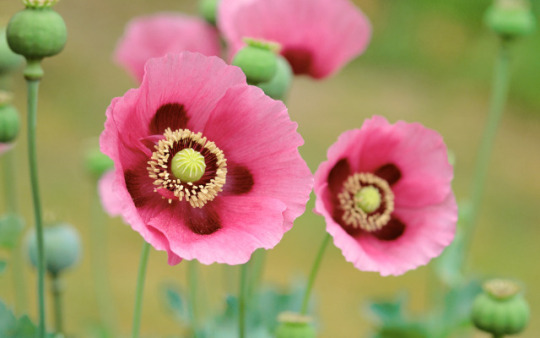
Now, originally I had assumed no waterlily or lotus is psychoactive so considered it might be a poppy instead, with the pink poppy looking the most similar to the flower in episode 6. The flowers we see are clearly growing singularly from the garden soil, rather than floating in water the way waterlilies and lotuses do. However, not only do these flower in full sun rather than nocturnally, it also turns out that there ARE psychoactive lotus flowers. Specifically Nelumbo nucifera or the blue lily flower and Nymphaea caerulea or the blue lotus, although these too bloom in the day and close up at night.
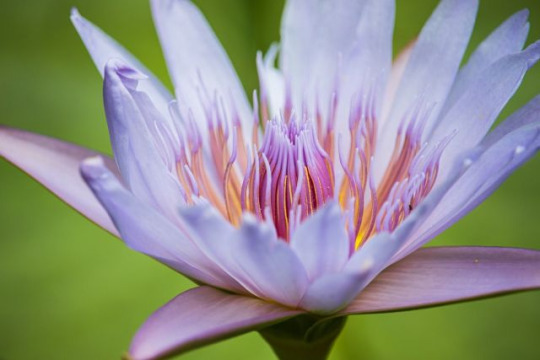
The broader taxonomy of Nymphaea nouchali / water lily has edible psychoactive roots (containing alkaloid aporphine).
It's pretty fitting for Fowler to cultivate a nocturnally blooming flower, given his crescent moon crest. Not sure if that crest is his or that of the Genghin clan, but he dons it all the same.


With all that being said, the psychoactive effects of the flower seem to stem (heh) from its pollen, not its petals as with Nelumbo nucifera. As it happens, there is a plant native to Japan which has psychoactive pollen containing "grayanotoxins" (named after Asa Gray from the 1800s. If Fowler talked about the plants it would be very anachronistic for him to use this term, so he probably wouldn't). These are a type of neurotoxin produced by the family Ericaceae (including the rhodedendron flower - not especially similar to Fowler's flower as they tend to grow in clusters with relatively smaller flower heads), with the different isoforms (structure variations) of the grayanotoxins each flower species produces varying the plant's toxicity. Whatever grayanotoxins are in Fowler's flowers' pollen act pretty quickly so are probably on the more potent end (so probably grayanotoxin III?)
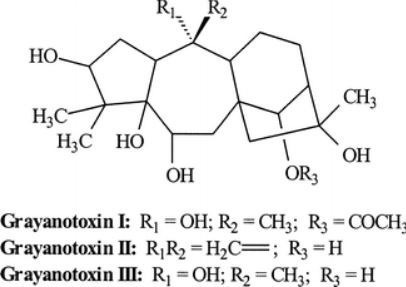
"Mad honey" can be made from pollen contaminated with grayanotoxins, but the pollen itself is still psychoactive.
Overall, no specific existing flower species seems to perfectly fit Fowler's flowers. Lotus look the closest but don't grow in the conditions shown in the show and have psychoactive roots rather than the psychoactive pollen of rhodedendron flowers. If any BES fans are botanists or specialise in plants / environmental science / botany / related sciences, I'd love to hear what you know and think would be more appropriate candidates!
#blue eye samurai#abijah fowler#abijah blue eye samurai#Post didn't show up on the tags for some reason so fiddled around with it until it did#Another tangent about details that don't matter but brainrot got me good#Tempted to plant some blue lotuses and rhodedendrons now#botany#plants
29 notes
·
View notes
Text
Miss. Peregrine’s Museum of Wonder’s has a Taxonomy of Peculiar Abilities
⚠️ SPOILERS! ⚠️
these are what type of peculiar’s the group are classified as stated in the taxonomy:
Hugh Apiston - Animal Communicator
Fiona Frauenfeld - Earthworker
Jacob Portman - Deadriser*
Emma Bloom - Fire-Starters aka Sparks
Noor Pradesh - Light-shaper
Millard Nullings - Invisible
Victor & Bronwyn Bruntley - Fortae
Horace Sumnusson - Mentalist
Enoch O’Connor - Deadriser
Olive Abroholos-Elephanta - Zephyr
Claire Densmore - Anatomically Unique
*Miss. P says Jacob’s title is out-dated as they have learned more about Librarians, but it’s his official type as of now.
#mphfpc#miss peregrine#miss peregrines museum of wonders#miss peregrines home for peculiar children#hugh apiston#Fiona faruefeld#jacob portman#emma bloom#noor pradesh#millard nullings#bronwyn bruntley#victor bruntley#horace somnusson#enoch o'connor#olive elephanta#olive abroholos elephanta#claire densmore
237 notes
·
View notes
Text
field trip
cw: moderately suggestive imagery, female bodied reader (if you're not okay with this type of content, please do not interact)
its only been a few hours, but atsumu's already grown frustrated in both directions; the dull throb behind his head and the fabric of his shirt -- most probably stretched beyond repair -- bearing witness to his agitation. The two of you have been supposedly standing in the waves for hours, picking and gesturing at various sea creatures below -- this clam, that piece of kelp, the little fish here -- with your enthusiastic and extensive commentary, of course, with him agreeing with a noncommittal noise when you pause to take a breath. It's really the only way for him to convince you that he's still engaged in conversation (you lost him at taxonomy), as he's begun to focus on your hands rather than whatever they were pointing at, distracted by their flushed state underneath the afternoon sun, sweat trickling so elegantly upon the planes of your fingers. And he allows his eyes to travel a bit higher, sailing over your exposed abdomen to rest just under the valley between your breasts, struck by how your bikini flutters with every breath of yours; as if it wasn't fastened tightly enough to surreptitiously tease your contour with every dip and strain of fabric against your skin.
Greeted with the presence of your hair as a few strands sweep your shoulders, and you make to move them away, embarrassed, exposing the long column of your neck and Adam's apple, painted with streaks of sunscreen and speckled with sand and seasalt, begging to be picked -- or kissed -- away. His frustration blooming into thinly veiled pain, berating himself for allowing himself to suddenly become so needy when he should be participating with you, like a good boyfriend would. Stroking and smoothening the sunscreen from your neck, like a good boyfriend would, before skimming the delicate skin there with his lips, obediently and meticulously, just like you deserve it. Burying his head in your neck, feverish lips seeking refuge in the shell of your ear, starting a new conversation the two of you would like. It's okay you're hot and bothered; he can help you cool down after.
"Hey, y/n," he interrupts after you finish talking about pelagic jellyfish, sly grin adorning his face. "Why don't you come here? There's something I gotta show you."
#haikyuu x reader#haikyuu!!#hq drabbles#hq headcanons#hq x reader#haikyuu angst#haikyuu x y/n#atsumu x you#haikyuu atsumu#atsumu x reader#atsumu drabble#miya atsumu#hq atsumu#atsumu headcanons
95 notes
·
View notes